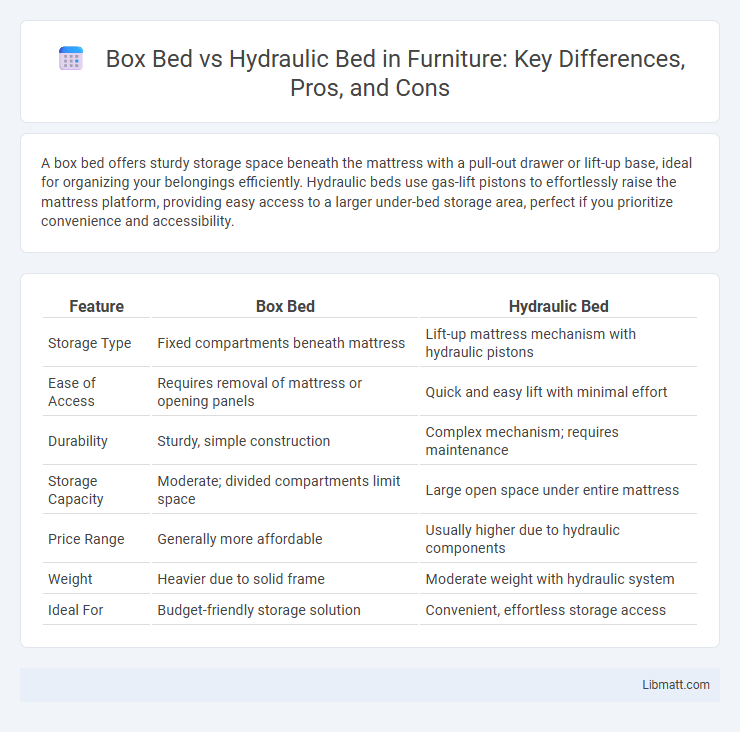A box bed offers sturdy storage space beneath the mattress with a pull-out drawer or lift-up base, ideal for organizing your belongings efficiently. Hydraulic beds use gas-lift pistons to effortlessly raise the mattress platform, providing easy access to a larger under-bed storage area, perfect if you prioritize convenience and accessibility.
Table of Comparison
| Feature | Box Bed | Hydraulic Bed |
|---|---|---|
| Storage Type | Fixed compartments beneath mattress | Lift-up mattress mechanism with hydraulic pistons |
| Ease of Access | Requires removal of mattress or opening panels | Quick and easy lift with minimal effort |
| Durability | Sturdy, simple construction | Complex mechanism; requires maintenance |
| Storage Capacity | Moderate; divided compartments limit space | Large open space under entire mattress |
| Price Range | Generally more affordable | Usually higher due to hydraulic components |
| Weight | Heavier due to solid frame | Moderate weight with hydraulic system |
| Ideal For | Budget-friendly storage solution | Convenient, effortless storage access |
Box Bed vs Hydraulic Bed: An Overview
Box beds feature a simple, sturdy frame with storage space beneath the mattress, ideal for maximizing room efficiency. Hydraulic beds incorporate a lift mechanism powered by gas pistons, providing easy access to the storage area with minimal effort. Choosing between a box bed and a hydraulic bed depends on your preference for manual access versus automated convenience.
Design Features of Box Beds
Box beds feature a sturdy wooden frame with solid panels enclosing the mattress, creating a cozy, enclosed sleeping space ideal for tradition and insulation. The raised box design often includes under-bed storage compartments or drawers, maximizing bedroom organization. In contrast, hydraulic beds incorporate lift mechanisms, but box beds emphasize robust craftsmanship and classic, space-saving storage solutions.
Design Features of Hydraulic Beds
Hydraulic beds incorporate a built-in lifting mechanism powered by gas or electric pistons, allowing users to effortlessly raise the mattress to access spacious under-bed storage. The frame is typically reinforced with sturdy metal components to support the lifting mechanism and ensure durability. Unlike box beds that rely on a stationary frame with external drawers, hydraulic beds optimize space by elevating the entire mattress platform, blending functionality with a sleek, modern design.
Storage Capacity Comparison
Hydraulic beds offer significantly more storage capacity compared to box beds due to their lift-up mechanism, which utilizes the entire base area for storage. Box beds typically have fixed compartments or drawers that limit accessible space and organization options. The hydraulic system maximizes under-bed space, providing easy access and the ability to store larger items efficiently.
Ease of Use: Manual vs Hydraulic Mechanisms
Box beds rely on simple manual mechanisms, making them straightforward to operate but requiring more physical effort to lift or adjust. Hydraulic beds incorporate fluid-powered systems that provide smooth and effortless lifting, enhancing convenience and reducing strain for users. The hydraulic mechanism offers superior ease of use, especially for frequent adjustments or heavier loads.
Durability and Maintenance
Box beds feature a sturdy wooden frame known for long-term durability but may require regular tightening of joints and occasional refinishing to maintain appearance. Hydraulic beds incorporate metal mechanisms that provide smooth lifting functions but demand periodic lubrication and inspection to prevent mechanical wear and ensure longevity. Both types require proactive maintenance to preserve structural integrity and operational reliability over time.
Cost Differences
Box beds generally have a lower upfront cost compared to hydraulic beds due to their simpler design and construction. Hydraulic beds incorporate advanced lifting mechanisms that increase manufacturing expenses and result in higher retail prices. Your choice between the two should consider budget constraints alongside the convenience and functionality offered by hydraulic models.
Aesthetic Appeal and Customization
Box beds offer a classic, enclosed design that enhances aesthetic appeal with a cozy, vintage look, while hydraulic beds provide a sleek, modern appearance with smooth lines and integrated storage. You can customize box beds with different finishes, fabrics, and detailing to match traditional or rustic decor, whereas hydraulic beds allow for versatile customization in terms of lifting mechanisms, colors, and materials that suit contemporary interiors. Both styles offer unique visual and functional customization options to elevate bedroom design according to your preferences.
Space Optimization for Small Rooms
Box beds offer efficient space optimization by providing built-in storage compartments that maximize under-bed usage in small rooms. Hydraulic beds enhance space-saving by allowing easy lifting of the mattress platform, revealing a large storage area ideal for bulkier items. Both designs improve room organization, but hydraulic beds typically offer more accessible storage without compromising floor space.
Which Bed Type is Right for You?
Choosing between a box bed and a hydraulic bed depends on your storage needs and ease of access preferences. A box bed offers straightforward under-bed storage with a fixed base, ideal for keeping bulky items organized but requires pulling out drawers or lifting a lid manually. A hydraulic bed features gas-lift mechanisms that allow smooth lifting of the mattress frame, providing more spacious and easily accessible storage; your decision hinges on whether you prioritize convenience or simplicity in your bedroom setup.
box bed vs hydraulic bed Infographic

 libmatt.com
libmatt.com